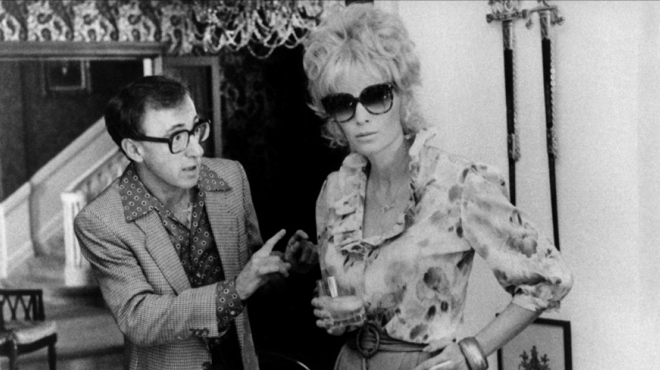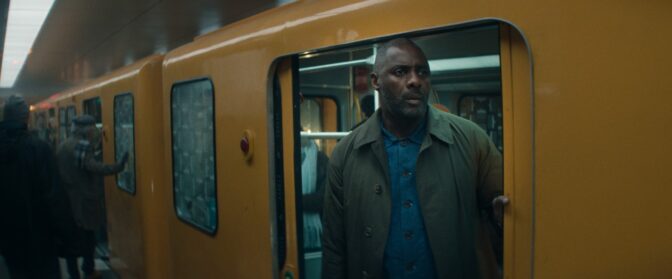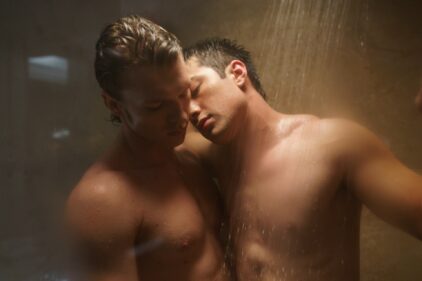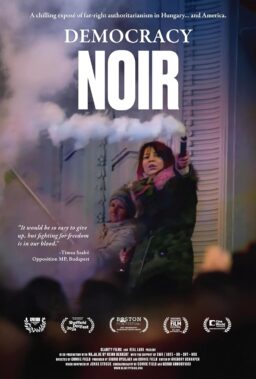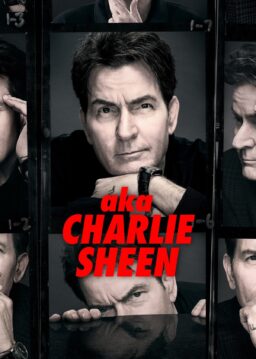“Broadway Danny Rose” (Twilight Time)
Good gracious, forgot Milton Berle was in this. I can tell I’m entering my dotage, as I actually get excited about Milton Berle cameos these days. This 1984 concoction is one of writer/director/star Woody Allen’s most enjoyable diversions, jam-packed with bon mots such as “Don’t forget to do ‘My Funny Valentine’ with the special lyrics about the moon landing.” The black-and-white cinematography from the late, great Gordon Willis combined with the amazing faces of the real life Borscht-Belters and showbiz schnorers Allen assembled for the cast makes the whole thing look like a Drew Friedman cartoon come to life. The transfer shows off good grain, minimal shimmer/noise. Worthwhile. B+

“Fargo” (Fox)
A new transfer shows off its value from the very first shot, a reverse-climate homage to a famous horizon shot in “Lawrence of Arabia“: approaching headlights in the long distance through the snow. Sharper, brighter (but not too much brighter), more detailed. Flesh tones are also more evened out. William H. Macy, while always visibly flustered, doesn’t look quite SO red. As for the movie, well, you know. Although after not having seen it in a while I have to admit I was ever-so-slightly shaken by how brutal it was. The extras are the same from previous editions, including a terrific commentary by cinematographer Roger Deakins. A

“55 Days At Peking” (Carlotta, Region-B-locked Import Disc)
By the early ‘60s, Nicholas Ray had become even more of a nervous wreck than he had been during his directorial heyday, and while he’d managed to pack some integrity and idiosyncrasy into his Christ story “King of Kings” (a.k.a., by the likes of some “Rebel”-remembering quasi-wags, “I Was A Teenage Jesus”), he was in pretty bad shape going into his second Samuel-Bronston-produced Big Picture. Hence, this Boxer Rebellion drama has an insane production dysfunction story behind it, and the end product is very nearly as maudit as auteur pictures get. A weird, meandering picture that’s as physically beautiful as all get-out. This French disc is super gorgeous and very nearly noiseless, except for some shimmer on a white pillow during Ava Gardner’s death scene. The edition also has LOTS of extras, including Olivier Assayas talking about the film, and China, for 35 minutes. Only in French without English subtitles. So if you don’t understand French maybe wait for a British or American edition. B+

“Funny Face” (Paramount)
The mavens (okay, a maven or two) on the home theater forums have been making some rueful “what might have been” comments, upset that a particular mastering person did not stick around at a particular place to supervise this particular Blu-ray of the Stanley Donen 1957 musical. Very, very detail-oriented folks may indeed speculate on how sequence X might have been specifically boosted, but, for this viewer, the color-soaked movie, shot in rich and detailed VistaVision, is just a remarkable Blu-ray confection from start to finish. “Think Pink” is Pepto-Bismol magnifique; Audrey Hepburn’s beatnik act in the Caveau de Huchette (or some approximation thereof) is still smokily evocative and sexy. And that all-black-except-the-socks outfit she wears looks really black, not dark gray; so all’s right with this disc’s world, as far as I’m concerned. This movie bugs some people because of the age-inappropriateness of the Hepburn-Fred Astaire pairing. Whatever. They’re both dead now so there’s nothing we can do about it. A

“The Greatest Story Ever Told” (MGM)
I think it’s sweet that MGM is marketing the Blu-ray of this 1965 picture under an “Epics of Faith” rubric. The damn thing DESERVES AN AUDIENCE. Widely derided as one of George Stevens’ worst movies, its sincerity gains poignancy when you process its love-and-especially-peace message through Stevens’ own backstory. (See Mark Harris’ great book “Five Came Back,” for starters.) I think it’s a remarkable artifact, and an often interesting film, not without gracious or graceful moments…although the constant parade of cameos can be distracting. “We have brought this film to Blu-ray using the best materials possible” a note at the beginning pledges. That’s a bad sign. Bare-bones, without restoration, the Ultra Panavision 70 197-minute version; well, I guess the studio wasn’t going to stump for a “Ben-Hur”-like deluxe edition. The reviewer at Blu-ray.com lamented, “the worst thing about this transfer, aside from damage to the master itself, is abundant flicker, registration differences and a lot of artifacting, including low grade noise, shimmer, aliasing and moiré.” For civilians, that means that it looks shaky, scratchy and soft a lot of the time, although in certain shots there’s good detail and color, and the movie as a whole is entirely watchable. Still a specialty item though… C+

“Master of the House” (Criterion)
Cinema maestro Carl Dreyer is known for challenging, uncompromising cinematic explorations of faith (“Ordet“) and dread (“Vampyr”) and sometimes faith and dread (“Day of Wrath,” “The Trial of Joan of Arc”) So this 1925 film may surprise some: it’s domestic drama. The presentation here is a huge step ahead of the BFI standard-def edition of almost eight years ago, seemingly derived from different materials and given a good scrubbing, although no fake DNR sheen. It doesn’t feel, at least immediately, like a Dreyer film although its fluency and relative innovation do shine through, and scholar David Bordwell has an excellent supplement here that will guide/convince the skeptical. I am not crazy about the piano score. That is my only complaint. A

“Men In War” (Olive)
I’ve been nuts about this Anthony-Mann-directed Korean war horror story since I first saw it in repertory years ago. It’s been hard to see in a really good presentation for many years, and I’ve been wondering if it would hold up. Good God, does it ever. Mann brings a new piquancy to ironies that were presented in the likes of “All Quiet on the Western Front” as he breaks new ground in depicting the non-metaphorical madness of war. The storyline is suspenseful as hell too. The Blu-ray presentation is not perfect, but it’s mighty strong. The piercing irises of Aldo Ray are piercing indeed, which helps the movie do its nerve-wracking job very well. A

“Mr. Hobbs Takes A Vacation” (Twilight Time)
Sometimes I feel like I “get” the sensibility behind boutique label Twilight Time’s releases pretty well. But when I first looked at this, a 1962 comedy starring James Stewart and Maureen O’Hara, I was slightly mystified. This is the kind of film that was all the rage in the early ‘60s: aging male star, once a romantic lead, is cast as head of a really annoying family that puts him through absolute hell, until the denouement that insists that family life is in fact splendid and really the ONLY THING WORTH EXISTING FOR. Of course, James Stewart, his hair darker than it was in “Vertigo,” can sell this sort of thing in his sleep. There’s a real sociocultural fascination to this subgenre, of course, but the cinephile appeal is perhaps more elusive. However. This is another Fox production in CinemaScope, directed by Henry Koster, the man behind the camera for other Fox Scope productions such as “The Robe,” “Desiree,” and, God bless him and Debra Paget, “Stars and Stripes Forever.” Among others. (“Desiree,” which proved Brando had learned to phone it in by the ‘50s, is also a Twilight Time disc.) And the Scope image is quite lovely and apt and interestingly deployed, particularly in an awkward bathroom scene with Stewart and one-time studio sex symbol Marie Wilson. For Scope junkies only/probably. But they will like. B
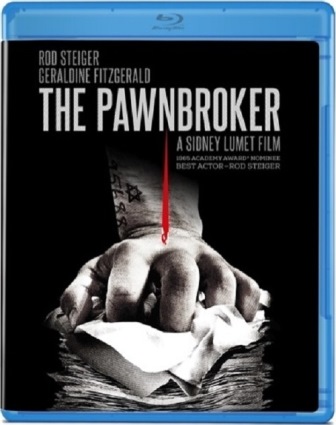
“The Pawnbroker” (Olive)
Sidney Lumet’s drama of a lonely, tormented Holocaust survivor not making friends in Harlem has its overwrought moments to be sure, but it also features what’s probably Rod Steiger’s best performance. Lumet’s own recollections of how he did not have to talk Steiger into underplaying are fascinating. (But they’re not found here, as this is a typically extras-free Olive disc.) I wish every other director except Sergio Leone who ever worked with Steiger had been able to so constructively get the actor to dial it down. The image here is very crisp. And rather brighter than one might imagine, for such a relentlessly dark and sad film. A near-essential New York almost classic. If you think that’s faint praise, you don’t know me very well. B+

“Rita Sue And Bob Too” (Twilight Time)
Seminal British director Alan Clarke wasn’t exactly known for his comedies—his essential “Elephant” was an inspiration for the terrifically grim Gus Van Sant film of the same name—but he was the right man to adapt a play by Andrea Dunbar, a blazingly frank and aggressive bedroom (and car backseat) near-farce set in the British underclass. This 1987 movie was his penultimate film—he died tragically of a heart attack at age 54, two years after making this. Dunbar herself died at age 29. This movie’s visual plainness is deceptive, as the picture itself is full of life…extremely uncomfortable life. The scene at the outset where married Bob “seduces” babysitters Rita and Sue on the pretext of driving them back to their homes is both watch-through-fingers uncomfortable and jaw-droppingly hilarious. That said, the movie, with its incredibly drab settings and purposefully spotty-looking people, is not what you call demo-disc material. A remarkable, has-to-be-seen-to-be-believed movie though. Awfully cheesy opening theme music though; way to kill a potential buzz, Michael Kamen. B+

“Sleep, My Love” (Olive)
Douglas Sirk himself was not crazy about this 1948 thriller. Despite the fact that Claudette Colbert and Don Ameche had made an apt screen team more than twice before, they’re both terribly miscast here; still-spunky CC is obliged to play helpless wife to amiable Ameche’s would-be gaslighter. OK, if you say so. Thing is, Sirk applies so much visual brio to the proceedings, and supporting players George Coulouris and Hazel Brook are so compelling it’s very easy to watch anyway. Mary Pickford “presented” the picture. The Olive disc start off pretty shaky, with a lot of shimmer and variation in the opening credits, but settles into an acceptable look quickly after that. Be on the look out for the shot Sirk lifts from Hitchcock’s “Suspicion.” B

“Sorcerer” (Warner)
William Friedkin’s masterpiece (yep, I’m one of the guys who thinks so) has been personally supervised by Hurricane B. for its Blu-ray debut and boy does this 1978 movie look…distinctive. It opens on some pretty BRIGHT notes. During the French sequence, you think, man are those trees GREEN. Did Friedkin oversaturate the colors from the original? It’s odd, the movie was pretty much reviled on its initial theatrical release, and suddenly it seems a generation that wasn’t even around to see it the first time has gotten all protective about its look. This disc pops likes it’s nobody’s business, some of it looks like it was shot yesterday, and that makes people suspicious. However, having watched the whole thing on disc twice, I’m convinced Friedkin did the right thing with it, because the visual scheme has what you could call a narrative arc of its own, and this transfer articulates it with everything the high-definition video format has to give it. No extras to speak of and doesn’t need ‘em. Also: this movie should be played LOUD. A

“Stranger on the Prowl” (Olive)
Did shooting in Italy affect Joseph Losey’s style at all? I noticed a very familiar pattern from a lot of ostensibly neorealist pictures shot in Italy around the same time (early 1952): a medium shot of two characters, followed by a high-angle medium closeup of one of the characters. You don’t see it that much in Losey movies before or after this one, which Losey disowned. “I gather it was widely re-edited and shortened. I’ve never seen it, I don’t know,” he told Tom Milne in the late ‘60s. I don’t blame him for his lack of enthusiasm. Between star Paul Muni’s Master Thespian bathetic mugging and the sub-“Shoeshine” mechanics of its storyline, this is a problem picture in all the least desirable senses of the term. I’d say “for Losey completists only” but I’m a Losey completist and I’m not sure if it’s really for me. The fact that the image is on the less-distinguished end of the always unpredictable Olive scale—scratchy and often soft—is another anti-selling point. C
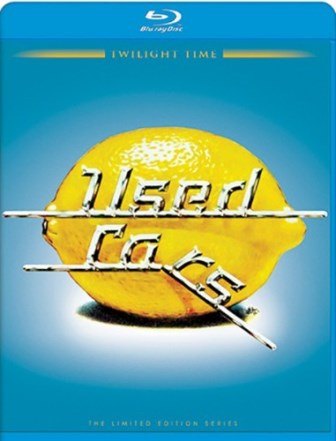
“Used Cars” (Twilight Time)
The case for Robert Zemeckis as a twisted, Sturges-inflected quasi-satirist rather than faux-Capra for yuppies starts with this 1980 picture, which he co-wrote with Bob Gale. Beneath the copious profanity and deliberately crass instances of nudity, this really is a screwball comedy with pace and attitude that just don’t quit. It was also the first movie to break the great Kurt Russell out of the Disney straitjacket, which he’s since done so convincingly that most people on earth today aren’t aware he was ever in a Disney straitjacket in the first place. The salient feature of this good-looking Blu-ray is merely the fact of its existence, honestly. It’s a movie more people ought to know, and this will help. Also, it features bit parts from Alfonso Arau and Al “Grandpa Munster” Lewis; how much more of a recommendation do you need? B

“The Visitor” (Drafthouse)
Another pretty eye-opening movie from the Drafthouse people, whose version of “Wake In Fright” some months back impressed me. This time the fare is a genuinely bizarre 1979 sci-fi picture set in Atlanta (tax incentives) and opening with a suitably Biblical-looking John Huston doing cosmic battle in a desert. Followed by a scene featuring Franco Nero as a blond Jesus. Or something. Despite its dismissal in the “Psychotronic Encyclopedia of Film,” this really is a notably bizarre picture, the flourishes of which suggest Ted Post channeling Alejandro Jodorowsky. The transfer provides the movie with an apt look, e.g., that of a ‘70s low-budget sci-fi shot on cheap, fast stock. Extras are minimal, but the movie itself provides a lot of quirky voltage. B+

“The War Lord” (Eureka! Region-B locked U.K. Import)
Known mostly for being the first collaboration between star Charlton Heston and his future “Planet of the Apes” director Franklin J. Schaffner, this 1965 movie is not quite as action-packed as its title suggests. (Note: it’s adapted from a play called, ahem, “The Lovers.”) It’s actually a moody, medieval chamber piece with elaborate production values; its aspirations to high-seriousness somewhat undercut by the likes of Richard Boone and James Farentino skulking about. The real news here is what a beautiful Blu-ray image it presents, the widescreen and the color looking super-spectacular. (The movie was shot by old Universal hand Russell Metty, who’d done black-and-white magic for Welles and b&w AND color magic for Douglas Sirk, so it stands to reason.) The whole thing really “pops” without looking big-boxish. To the extent that this is an absolute joy to watch even if you’re not following the plot, in which droit du seigneur gets hero Heston (who turns in one of his most understated performances here, if you’re interested) into some hot water. A

“Wild At Heart” (Twilight Time)
In an on-screen interview for the MGM standard-def Blu-ray, director David Lynch goes into detail on the process of color timing movies both for the theater screen and home video, and recounts some difficulty in getting it right for his insane, and insanely visually varied, 1990 lovers-on-the-road movie, adapted from a slightly more earthbound Barry Gifford novel. Featuring Nicolas Cage in the role he was born to play. As I hope we all know. Anyway, “we tweaked that bad boy,” Lynch says, and came up with “a really good high-def master.” I presume this Blu-ray is from same, and for the most part it does look really good, capturing the movie’s eccentric, all-over-the-map, and quintessentially Lynchian visual textures: windshield grime, burning tobacco flakes, red red gloppy lipstick. The super-grainy textures of the night time driving scene in which the principles happen upon a grisly auto accident might give some viewers pause, but the fact is that this is an upgrade over the previously available foreign-region high-def versions overall and hence pretty much a must. The voluminous and odd extras are from the 2004 MGM disc. A

“Young At Heart” (Olive)
Visually astute journeyman director Gordon Douglas brought some welcome fluency to this rethink of the 1938 “Four Daughters,” itself adapted from a story by Fannie Hurst of “Hope For The Best, Expect The Worst” fame. The 1.66-ish image of this not-uninteresting melodrama-with-musical-numbers (and only three daughters this time) starts shaky, builds to a nice solidity, and is quite watchable throughout. Solid direction aside (most notable in the nuanced, ambiguous way Douglas depicts a suicide attempt by one of the lead characters late in the film), the picture is most notable for its cast. Crabby Frank Sinatra charms sunny but not saccharine Doris Day, much to the heartbreak of Gig Young, who a few years hence would lose Katharine Hepburn to old Spencer Tracy in “Desk Set.” Guy couldn’t catch a break in the ‘50s. Robert Keith, Dorothy Malone, and Ether Barrymore also wander through the very nice Connecticut house in which the picture is set. Look out for the nightclub scene in which dejected piano player Sinatra performs “Someone To Watch Over Me” to a house that couldn’t care less; it’s like a dress rehearsal for Zappa and the Mothers’ “America Drinks And Goes Home.” B+
ODD AND ENDS:
A pleasing development in Blu-ray is Universal’s limited edition Archive series, which recently released Orson Welles’ “Touch of Evil” and Billy Wilder’s “Double Indemnity,” in newly mastered editions. Both of these pictures, collectors know, have gotten first-rate treatment from the Britain-based label Eureka!/Masters of Cinema. The domestic “Touch of Evil” is not as exhaustive an endeavor as the MOC, declining to explore aspect ratio variation and presenting three versions of the movie—theatrical version, 1998 reconstruction, and preview print—in 1.85. As for “Indemnity,” the new transfer in the Archive edition is notably brighter and, let’s say, “creamier” than what’s on the more recent MOC disc. I’m glad to own both versions of both films—I think the supplements on the MOC discs are more critical, scholarly and satisfying—but I’m also glad that viewers who don’t have region free players can have access to high-def versions of these essential movies. And while the conflict of interest prevents me from reviewing them in this forum, I would like to point out to readers who DO have region-free players that two excellent U.K. releases—Arrow’s rendition of Jack Hill’s too-little-seen “Pit Stop,” and Eureka!/MOC’s high-def treatment of Elia Kazan’s “Boomerang“—both feature booklet essays by your humble correspondent. Who is taking this column and bringing it back to the blog Some Came Running. While it’s been great fun contributing my two cents on Blu rays to RogerEbert.com, the fit wasn’t what it could be. I’ll be contributing other stuff to the “Balder And Dash” section, and of course continuing with the reviews.

